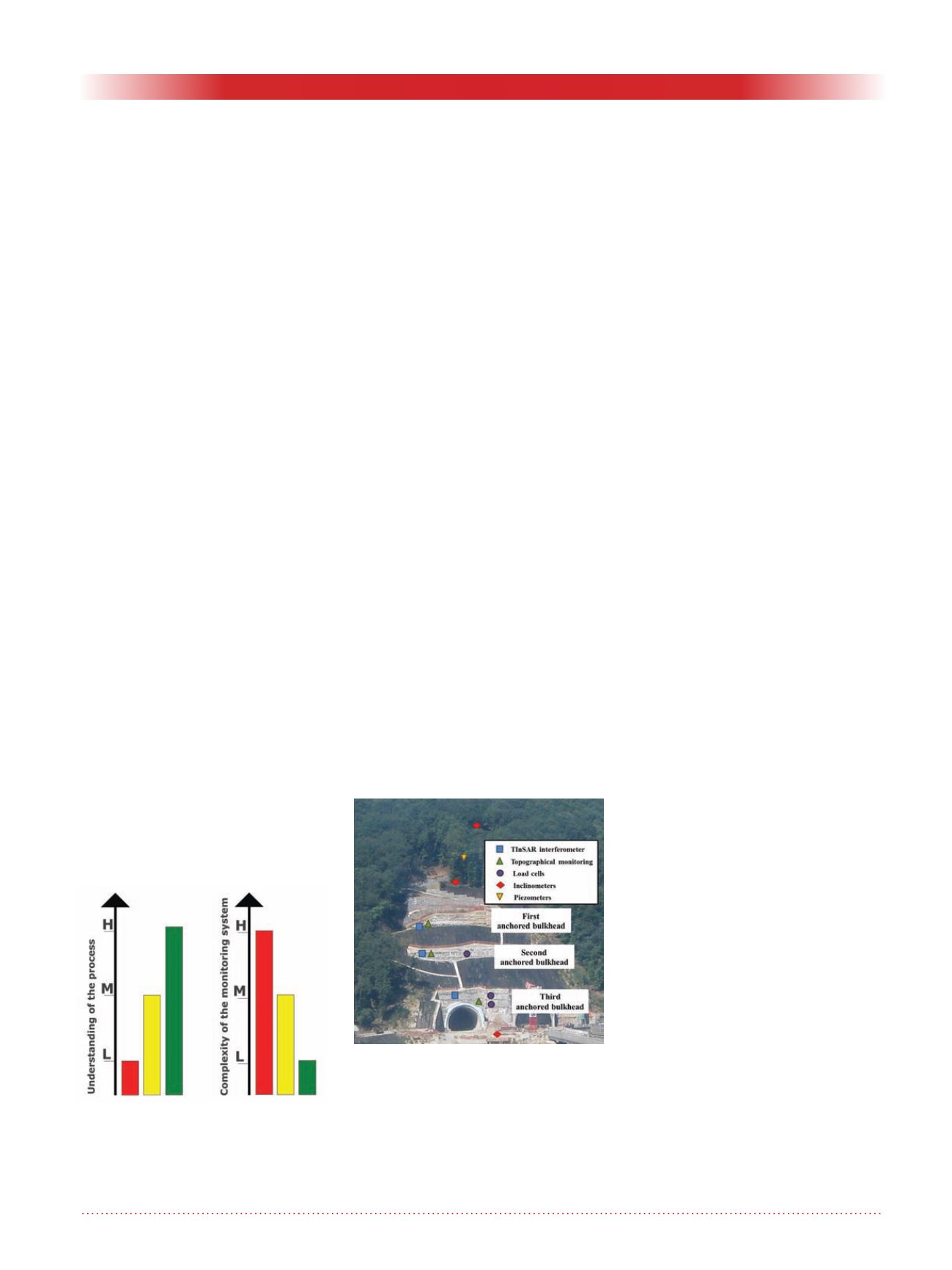
Geotechnical News • March 2015
31
GEOTECHNICAL INSTRUMENTATION NEWS
Lesson learned from two case histories about the planning of
integrated monitoring systems
Francesca Bozzano
The primary lesson
During the past eight years as an engi-
neering geologist on a research team
studying geological risks, I have made
use of integrated systems to monitor
and manage ongoing instability pro-
cesses. These have included landslides
and ground subsidence. In our moni-
toring systems, contact instruments
and remote techniques have been used
for monitoring.
This article presents the primary les-
son learned from two case histories:
that a general inverse relationship
exists between the level of understand-
ing about the ongoing geological/
geotechnical process and the complex-
ity (and cost) of an efficient monitor-
ing system. Said another way – the
more we understand the process, the
less is the complexity and cost of the
monitoring system. In Figure 1, our
understanding of ongoing process is
shown at the left, in which the scale
indicates low-level (L), medium-level
(M) and high-level (H) of understand-
ing. The complexity (and cost) of the
corresponding planned monitoring
system is shown at the right.
The red bars represent case histories
characterised by an
a
priori
low-level
understanding, for which a highly
complex and integrated monitoring
system must be planned and executed
to close the information gap. The
green bars represent case histories
characterised by an
a
priori
high-level
understanding, for which a simple
and integrated monitoring system can
perform well.
Based on the lesson summarised in
Figure 1, efforts should be placed on
acquiring and organising qualitative
and quantitative information about a
specific process in firm reconstructions
using an approach that is largely used
in engineering geology. This approach,
which is known as the geological
model, is a very good planning tool for
efficient monitoring systems.
In the next section, two opposite case
histories are described: the first case
history is representative of a low-level
a priori
understanding of an ongoing
process; the second case history is
representative of a high-level
a priori
understanding of an ongoing process.
Case history 1
The first case concerns an unstable
slope that delayed the construction of
tunnels along a highway in southern
Italy. In February 2007, the tun-
nel entrances were destroyed by an
unexpected translational landslide
when the length of the excavated
tunnel was approximately 12m. The
volume of the landslide was approxi-
mately 10,000m
3
, which included
metamorphic rock debris from the
adjacent steep slope. At that time, the
tunnel alignment could not be changed
and stabilisation of the landslide was
imperative.
Geological and geomorphological
surveys enabled us to discover that the
landslide was embedded in an older
and larger and deeper quiescent/inac-
tive rotational landslide with a volume
of approximately 1,000,000m
3
. The
2007 shallow landslide was located at
the toe of the older and larger land-
slide, and was triggered by the tunnel
excavation.
In the following months, three bulk-
heads (Figure 2) anchored using 30m
long tiebacks were placed along the
slope to stabilise the shallow part of it.
An integrated monitoring system was
planned by considering uncertainties
in the volume of the ongoing instabil-
ity process, i.e., small instabilities
in the shallow section of a quiescent
Figure 1. Sketch of the relationships
between the level of understand-
ing for an ongoing process and the
complexity (and cost) of the moni-
toring system.
Figure 2. Photograph of the slope,
which shows the three anchored
bulkheads and the location of the
monitoring instrumentation. The
symbols for TInSAR monitoring and
topographical monitoring indicate
that they specifically observe the
bulkheads.


